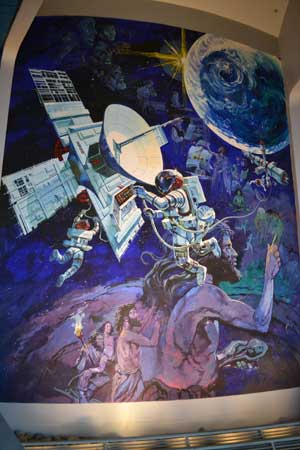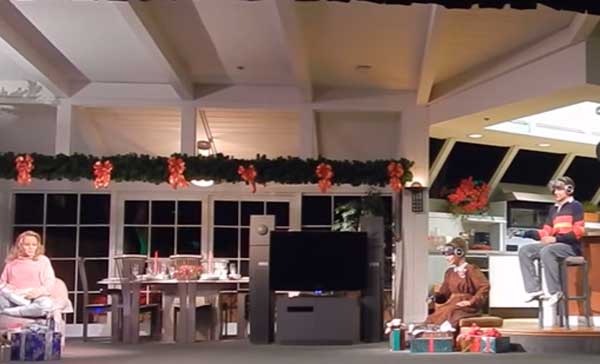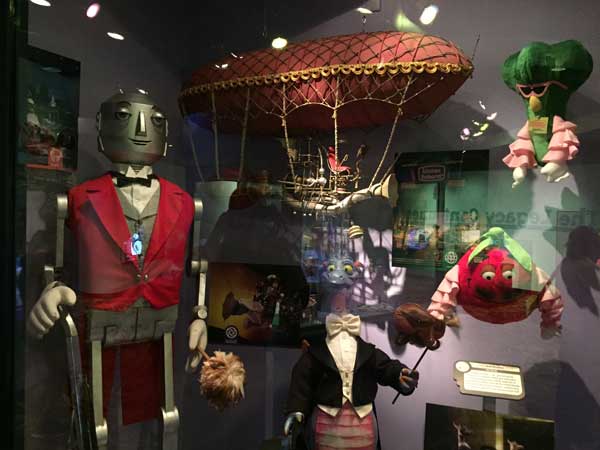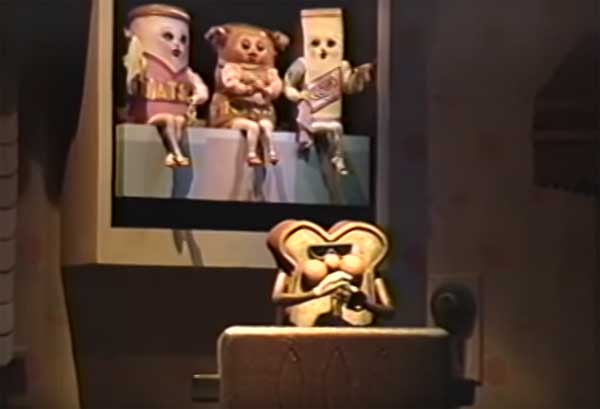This is not a post complaining about Walt Disney World. I still love it and would go there every week if I could! As serious Disney fans, we can’t help but look back to the parks of our childhood. I visited regularly during the ‘80s and ‘90s on family vacations, and those experiences resonate strongly today. What made Disney World stand out from other vacation spots? There were thrills, characters and fun experiences, but those weren’t the only reasons. I also really enjoyed the odd parts of the resort. For lack of a better term, let’s call them nerdy Disney World.
When I use the word nerdy, I don’t mean the more conventional use of fandom for properties like Marvel and Star Wars. They have become mainstream interests by this point. Most guests can’t wait to visit Galaxy’s Edge in the Studios and meet the Guardians of the Galaxy at Epcot. Disney is hitting softballs with those expansions in the parks. What I miss are the offbeat touches that differ from conventional theme park trends. A lot of these appeared in the original EPCOT Center, but they also made appearances in the other parks.
These creative choices are sometimes head-scratchers but don’t prevent Disney from gaining commercial success. In fact, they help to drive it. Small touches and mystery increase repeat visits to attractions for many years. Nerdy also refers to inclusions that don’t make easy sense to our minds. Book report attractions like Under the Sea are fine yet fail to leave a lasting impression. Mysterious places like The Haunted Mansion include layers of storytelling that confound us even after frequent visits. The parks become more than just places for passive entertainment. We’re engaged to figure out more about what rests beneath the surface.

The Fallacy of Edutainment
A common term that we hear to describe EPCOT Center is edutainment, which is synonymous with boring. Despite the entertainment part of the word, it undercuts the idea that the park was also magical. Don’t give people a history lesson on their vacations! What the idea of edutainment misses is how charming EPCOT Center was right from the start. Attractions like Spaceship Earth, Horizons, and Journey Into Imagination inspired us through originality, not typical education. If they encouraged us to learn more about the topic, that was a bonus.
Spaceship Earth is a perfect example of the nerdy aspects that I loved. The opening scenes with the cavemen were a little creepy to an eight-year-old in 1984. This mysterious aura continued through much of the ride, which included narration but not at the expense of visual story telling. Jeremy Irons’ narration in the 1994 update did an even better job in conveying the ethereal mysteries of the experience. That intrigue is largely missing from the Judy Dench version, which simplifies the script (first back-up system!) and concludes with a sight gag on screens. A bold vision of our past and future now offers a more limited view of our potential.
Horizons provided a mission statement for EPCOT Center with its visions of the future. Fans don’t love it just because of its thematic success, however. The small touches stick with us more than 18 years after Horizons closed. We cite the smell of oranges, the iconic robot butler scene, and even the bickering couple narrating the show as fond memories. Floating cities allow us to enjoy our lives, dad! Kelp should just be called seaweed. The beach boy is always late. There’s a reason that Hoot and Chief left their ride vehicles to explore Horizons. That pavilion connected with nerdy fans more than any other, and the tradition continues today.
Exploring Nutrition and Health
Some of the oddest nerdy experiences at EPCOT Center appeared in the Wonders of Life and The Land pavilions. The former included smaller presentations alongside its headliners Cranium Command and Body Wars. I’ll discuss those momentarily but have to mention that Martin Short appeared in a film about how people had babies. The Making of Me is even stranger than it sounds, especially for a Disney World trip. I’m not proposing we bring it back to Epcot, but I like the idea of trying something a bit awkward. The massive Wonders of Life pavilion offered Disney the ability to include a lot more than just a single attraction.
The real gem of that pavilion was Cranium Command, and it was really just a goofy way to showcase comedy stars of the ‘80s. I don’t believe we learned much in it, and that was fine. The impressive scale and weirdness could easily translate to today, with a few character switches (i.e., no Hans and Franz). Body Wars was Michael Eisner’s first attempt to put thrills in Epcot, and it mostly just made us sick. Even so, lines like “I’m in an air sac, I need some help here. I’m being attacked by a white blood cell!” led to a campy ride. The mix of Star Tours technology with a queasy journey through the human body made it inconsistent but definitely not boring.
Wonders of Life offered a goofy take on health, but its eccentric style had nothing on The Land. I’d love to meet the executive that greenlit Kitchen Kabaret; who wouldn’t love animatronic foods signing about nutrition? The image of Bob Chapek proudly introducing something that silly at the D23 Expo would be amazing. Hosted by Bonnie Appetite, this show didn’t have the luxury of Food Rocks’ staple of obvious pop song parodies. Even so, it worked because it was so original. Kitchen Kabaret is one of the best examples of nerdy Disney World.

Speed Rooms and Circle-Vision
The Magic Kingdom had its share of nerdiness, particularly in the ‘70s and ‘80s. The cheesy wonders of If You Had Wings deserve their own blog post (I’ll get there sometime). Nothing about flights on Eastern Airlines to Mexico really connects to the future, but it works because of the weirdness. We all joke about the final scene of Carousel of Progress today; that vibe was all over Tomorrowland. Mission to Mars is another great example. Despite the space voyage, the technology felt wonderfully dated. There was none of that charm in Stitch’s Great Escape.
The Timekeeper mixed Jules Verne and steampunk with Robin Williams’ comedy, and it actually worked. That attraction’s sense of wonder is entirely missing from the Monster’s, Inc. Laugh Floor. Seriously, we need Circle-Vision technology back in Tomorrowland. The goofy décor remains in Tomorrowland despite the loss of The Timekeeper and Alien Encounter. I’m excited for Tron in a few years, but I don’t expect to see the clever touches in that attraction. Tomorrowland was all about speed rooms and Circle-Vision for me as a kid.
We haven’t seen as many changes to Adventureland and Frontierland, and nerdy touches remain in the Enchanted Tiki Room, Country Bear Jamboree, and Jungle Cruise. I’m nervous the first two will eventually face the chopping block for that reason. They’re entertaining shows that some fans love, but Disney may look to grow attendance through new expansions. There are still plenty of random diversions to enjoy in The Magic Kingdom, including Tom Sawyer Island and the Shooting Arcade. That variety connects directly to its commercial and creative success.

A Smorgasbord Park
Created long before the days of DVD behind-the-scenes features, the Disney/MGM Studios offered an exciting glimpse at movie making. Eisner was a movie guy, and his stamp is all over this park. Despite its weird layout and smaller number of attractions, the Studios had plenty to offer to nerdy fans. The Great Movie Ride included a scene from Footlight Parade, which was not well-known in 1989. That attraction’s cheesy story line was quite different from Universal’s more intense experiences and had lots of cool nods to movie history.
The opening-day version of the Studios included a walking tour that lasted several hours. Movie props, costumes, and even a scene from Honey, I Shrunk the Kids were featured. You even drove by The Golden Girls house and encountered The Love Bug. It was all nerdy! I’d never call the Studios my favorite park, but it had plenty of charm. The “Star of the Day” and Streetmosphere characters leaned into this rosy glimpse of Hollywood. I’d love to see a bit less commercialism and more oddball moments in the Studios’ next incarnation, but I’m skeptical.
New Hope for the Future?
What is the WorldKey Information System of modern Disney World? Can an exhibit match the kitsch factor of The Age of Information display? I don’t expect Disney to recreate these early wonders, but their spirit could inhabit new experiences. What made the WorldKey kiosks so fun was the touch-screen technology combined with the goofy host. They also were helpful since you could book dining on them. I’d love to see Disney play around with technology in clever ways that surprise us. It’s okay to have more kitsch at Disney World! That’s part of why so many of us like it; the nerdy touches enhance the parks.
There is promise on the horizon, thankfully. Disney and Universal are building immersive lands, and these areas need odd details to keep guests engaged. Galaxy’s Edge will only have two attractions, and fans will spend a lot of time just walking around the area. Disney has promoted the idea that aliens and droids will just walk around that land. It’s the perfect opportunity for nerdy touches. Pandora and Diagon Alley have their share of fun little corners, and Disney should do even more with the Star Wars areas. I love e-ticket attractions, and those are certain to be thrilling. Combining that excitement with nerdy fun can only make Disney World even better.
What are your favorite nerdy parts of Walt Disney World?
Stay updated on all the latest blogs and podcasts; join The Tomorrow Society today!
Related Articles
EPCOT Center’s Horizons: Why It Worked
Five Steps to Enhance Spaceship Earth




Leave a Reply